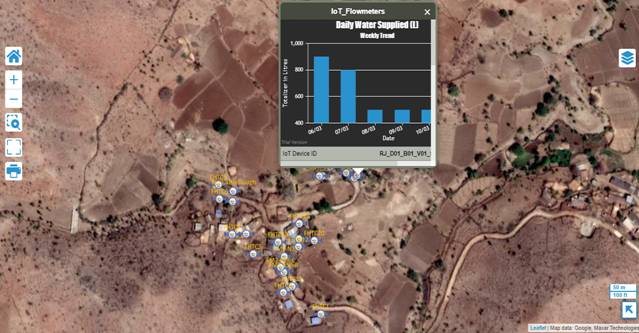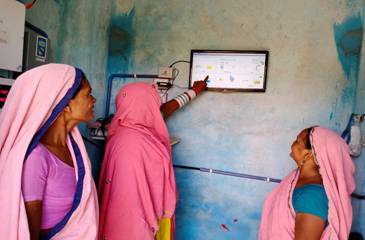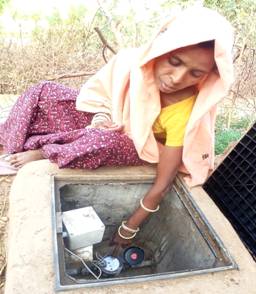Ministry of Jal Shakti
Jal Jeevan Mission deploys first-of-its-kind sensor-based IoT devices to monitor rural drinking water supply systems
Govt. of India’s digital vision to address challenges in rural water supply management
प्रविष्टि तिथि:
31 MAR 2021 4:06PM by PIB Delhi
To monitor the rural drinking water supply systems in villages, the Ministry of Jal Shakti has decided to take the digital route to usesensor-based IoT devices to effectively monitor the implementation of Jal Jeevan Mission (JJM) in more than six lakh villages. For this, National Jal Jeevan Mission in collaboration with Tata Community Initiatives Trust (TCIT) and Tata Trusts recently completed pilot projects in several remote villages of five States i.e. Uttarakhand, Rajasthan, Gujarat, Maharashtra, and Himachal Pradesh.A key feature of these pilots has been the use of frugal yet sturdy sensors, which makes the solution scalable and sustainable. One of the key challenges posed to the team was to develop a robust solution at a fraction of the water infrastructure costs (<10-15% of total scheme capex) without compromising on quality or functionality. These costs are expected to reduce further at scale. More importantly, majority of the vendors, including manufacturers, are Indian players, thereby giving a boost to Government’s AatmaNirbhar Bharat programme. The pilots went live in September 2020 despite challenges during CoVid-19 pandemic.
The Internet of Things (IoT) based remote monitoring provides near real-time information without any manual intervention by using sensors. This would not only allow effective monitoring and management on-ground, but also enable real-time visibility to State water supply/ PHED officials, and citizens. With a futuristic vision to ensure regular tap water to every home, real-time measurement and monitoring is critical for rural drinking water supply schemes, with enormous gains in terms of operational efficiencies, cost reduction, grievance redressal, etc. Data will drive improvement in service delivery and instill transparency for precious natural asset such as water. Thus, making a strong social and economic case for deployment of such a system.
Rural drinking water supply design varies considerably across different regions of the country. These pilots were spread across diverse agro-climatic conditions - including areas in western Himalayas, desert regions to Gangetic plains (spanning extreme cold of -100C to severe heat of 480C. These pilots cover different types of sources such as groundwater based borewells, springs in hilly areas, and surface water (river and dams) and villages with a population of a few hundreds to several thousands. The pilots also demonstrated a first-of-its-kind comprehensive (source to tap) remote monitoring and control system in a completely off-grid (using solar and battery only) rural environment in Sirohi district, Rajasthan.
Several types of sensors have been deployed including flow meters, ground water level sensors, chlorine analyzers, pressure sensors, pump controller etc. to measure all the relevant aspects of water service delivery – quantity, duration, quality, pressure, and sustainability – in addition to providing operational efficiencies. The cloud and analytics powered IoT Platform is integrated with a GIS (Geographical Information System) providing a robust decision support system.

The pilots have led to several outcomes as it has helped identify distribution issues – such as outages, leakages, low pressure, etc. and led to resolution across sites. It recently alerted both officials and community regarding fast depleting groundwater levels, that led the villagers to build a source strengthening structure to recharge their borewell. Other benefits observed include efficient and responsible use of water by community and reduced cost of operations through data-enabled leak detection, predictive maintenance, and automation.
|
Villages have a small TV screen installed with a visual dashboard in local vernacular, that helps the VWSC/ PaniSamiti take corrective actions. This has also led to a positive behavioral change. Earlier, water disinfection process was not carried out regularly in some of these villages. Now, the VWSC (PaniSamiti) sees a visual indicator on their village IoT screen telling when to disinfect water based on residual chlorine levels.
|

|
Customizing IoT for rural India is critical considering the Wi-Fi broadband and cellular connectivity. In fact, most locations in rural water network lack easy access to grid for powering such IoT devices, which is in an urban setting. “It requires using a combination of technologies such as RF and cellular for communications, and using solar or battery-based powering mechanisms for difficult to access locations. Further, optimizing data transmission rates can play an important role in enhancing battery life and keeping operating costs low”, mentions Mr. Siddhant Masson, Project Lead – IoT based Smart Water Management, TCIT.
The way forward
|
The success of these pilot projects has not gone unnoticed. Several States, including Gujarat, Bihar, Haryana, and Arunachal Pradesh, have already rolled out tenders for IoT-based remote monitoring systems ranging from 500 villages to several districts. Further, States like Sikkim, Manipur, Goa, Maharashtra, Uttarakhand have started the process to roll-out this technology.
Implementation of such innovative technology can directly boost several Union Government initiatives, including Aatmanirbhar Bharat, Digital India, Smart Village and also benefit the Smart Cities projects with an enhanced IoT ecosystem in the country; in addition to being the gamechanger for the drinking water supply sector.
|

|
Drinking water supply systems in Indian villages face multiple challenges of drying up of groundwater source, pump failures, irregular and inadequate water supply, etc. These challenges invariably aggravate socio-economic disparities, like women transporting water, often on foot over several kilometers; several water-borne diseases, which could easily be avoided; also, economic – wage loss and expenditure on medical care. The need of the hour is to ensure and put in place systems to effectively monitor and manage rural water supply.
Jal Jeevan Mission (JJM), Union Government's flagship programme, which is implemented in partnership with States/ UTs to provide tap water connection to every rural household by 2024envisions creating a Digital Wall and Remote Command & Control Centre for monitoring and managing supply of prescribed quality water in adequate quantity (55 Liters Per Capita per Day - LPCD) every day through household tap connections across all rural villages.
****
BY/AS
(रिलीज़ आईडी: 1708701)
आगंतुक पटल : 6645